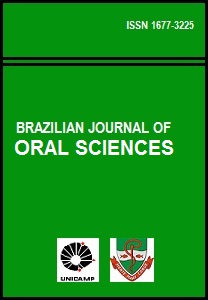Abstract
The aim of the present study was to analyze the impact fracture strength using plaster and resin modeling materials. The analysis was made using nine dies having plaster III bases and internal portion of laboratory-type addition silicone. Nine test specimens were produced of each following material: type IV Durone plaster, type IV Fuji Rock plaster, type IV Rock Plus plaster, type V Durone plaster, Epoxiglass 1504 epoxy resin, epoxy resin modified with diatomite and epoxy resin modified with diatomite. The tests were performed in a Ceast testing machine. At the moment of fracture, the machine recorded a value (Energy), using a formula to obtain the impact strength value in joules per meter. Statistical and variance analyses and Student’s t test revealed that pure or silanized diatomite increased the impact fracture strength of models made of Epoxiglass 1504 epoxy resin and that silanizing the filler led to a further gain in impact fracture strength. The models made of Epoxiglass 1504 displayed greater impact fracture strength than those made of plaster types IV and V. No statistically significant differences were found among the analyzed plasters. Models prepared with epoxy resin displayed in general greater impact fracture strength than models made of plasters.References
Hatzikyriakos A, Petridis HP, Tsiggos N, Sakelariou S. Considerations for services from dental technicians in fabrication of fixed prostheses: A survey of commercial dental laboratories in Thessaloniki, Greece. J Prosthet Dent. 2006; 96: 362-6 2. Rudd KD, Morrow RM, Bange AA. Accurate casts. J Prosthet Dent. 1969; 21: 337-45.
Phillips RW. Skinner’s science of dental materials. 9ed. Philadelphia: Saunders; 1991. 597p.
Gettleman L, Ryge G. Accuracy of stone, metal and plastic die materials. J Calif Dent Assoc. 1970; 46: 28-31.
Fan PL, Powers JM, Reid BC. Surface mechanical properties of stone, resin and metal dies. J Am Dent Assoc. 1981; 103: 408-11.
Friend LA, Barrett BE. Metal sprayed models from elastic impression materials: Preliminary study. Br Dent J. 1965; 118: 329-32.
Palmqvist S. Metal sprayed dies: I dimensional accuracy. Comparative study. J Dent Res. 1970; 49: 475-9.
Nomura GT, Reisbick MH, Preston JD. An investigation of epoxy resin dies. J Prosthet Dent. 1980; 44: 45-50.
Mackay PG. Physical properties of epoxy die resins [dissertação]. Indiana: Indiana University School of Dentistry; 1986. 90p.
Stevens L, Spratley MH. Accuracy of stone, epoxy and silver plate-acrylic models. Dent Mat J. 1987; 3: 52-5.
Dias SC. O uso da resina epóxica carregada com zirconita para obtenção de modelos, a partir de moldes com elastômeros [dissertação]. Ribeirão Preto: Faculdade de Odontologia de Ribeirão Preto, Universidade de São Paulo; 2000. 138p.
Gonçalves IN. Efeito do tratamento superficial da wolastonita na modificação do polipropileno [dissertação]. São Carlos: Centro de Ciências Exatas e de Tecnologia, Universidade Federal de São Carlos; 1995.
Kats HS, Milewski JV. Handbook of fillers for plastics. New York: Van Nostrand Reinlold; 1987.
Nielsen L. Mechanical properties of polymers and composites. New York: Marcel Dekker; 1974. v.2, cap.7.
The Brazilian Journal of Oral Sciences uses the Creative Commons license (CC), thus preserving the integrity of the articles in an open access environment.


